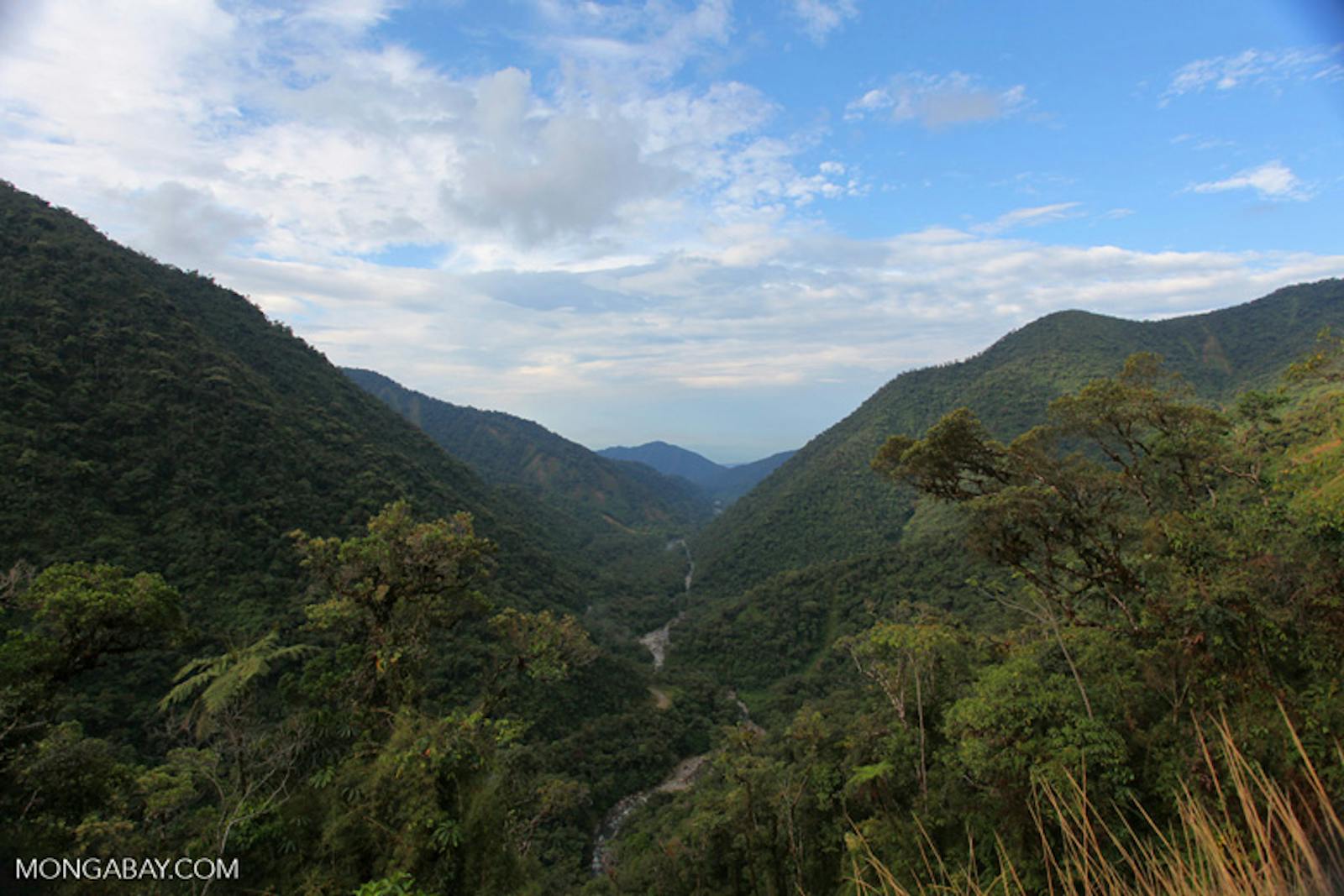Peruvian Yungas
The ecoregion’s land area is provided in units of 1,000 hectares. The conservation target is the Global Safety Net (GSN1) area for the given ecoregion. The protection level indicates the percentage of the GSN goal that is currently protected on a scale of 0-10. N/A means data is not available at this time.
Bioregion: Andean Mountain Forests & Valleys (NT11)
Realm: Southern America
Ecoregion Size (1000 ha):
18,712
Ecoregion ID:
493
Conservation Target:
51%
Protection Level:
3
States: Peru
The Peruvian Yungas represent an elaborate mosaic of Andean montane vegetation types. Steep slopes, ridges, and valleys each contain unique microclimates, while the vegetation is extremely diverse and can range from moist forest to dry forest. Endemic to the northern tip of this ecoregion and the adjacent Marañón Dry Forests ecoregion, the endangered long-whiskered owlet is one of the many unique species that inhabits the dense cloud forests of Peru. Little is known of this owlet, but its facial “whiskers”, stubby wings, and a short tail make it very distinctive, if it is ever spotted at night among the cloud forest epiphytes such as moss, bromeliads, and orchids; it may be nearly flightless.
.jpg)
The flagship species of the Peruvian Yungas ecoregion is the long-whiskered owlet. Image credits: Nick Athanas, Creative Commons
This ecoregion flanks the eastern slopes of the Andes, roughly from the Marañon Valley depression northern Peru to near the Rio Huari Huari (Cordillera Carabaya) near the Bolivian border. The yungas, or montane moist forests, occur in a mosaic of patches. Elsewhere within the ecoregion are patches of dry forest, submontane forests, high Andean grasslands, transitional scrub forests, and frequent and characteristic landslips, each with their own unique climate and vegetation and species associations.
The climate varies from moderately temperate at higher elevations to tropical at lower elevations, with heavy rains that can exceed 6,000 mm/year and declines between May and August. At altitudes above 2,500 m, average temperatures range from 6–12ºC (in the northern section) and 8–22ºC (in the southern section). In low areas, the average temperature is 25ºC. The ecoregion has complex geography with mountainous surface full of cliffs, ridges, hillsides and valleys, and a steep and highly dissected topography.
Vegetation and habitat types vary dramatically along a strong altitudinal gradient between Cordilleras and even between nearby valleys. It is an area with montane forest, premontane and lowland forests, dry forests, and high elevation woodlands. Below 2,700 m, the forest becomes richer in typical, lowland species such as cedar, trumpet-wood and relatives of papaya. Above 3,500 m, there are scrublands and wet rocky thickets with some shrubs and land orchids as well as forests of shepherd's needles.

Andean cock of the rock. Image credit: Creative Commons
This region maintains one of the richest montane forest ecosystems in the Neotropics. As a whole, plant diversity is extraordinary due to the elevational gradient and diversity of habitat types and microclimates, and strong degrees of separation and isolation between Cordilleras and similar habitats. Beta-diversity, or variation of species composition across different sites, is extremely high, as is (neo)endemism, with more than 3000 species of flora and more than 200 species of vertebrate fauna. There are at least 200 species of orchids with varying morphological forms. Below 3,500 m, there are cloud forests with the presence of bamboo and arboreal ferns.
This ecoregion has many species of endemic birds and butterflies such as the genus of Morpho. The Andean cock-of-the-rock is another species found in this ecoregion. Notable among mammals are the Incan shrew opossum and the Kalinowski's agouti, as well as the northern pudú and the hairy long nosed armadillo. It is also an area with a concentration of species with limited distribution such as the horned curassow, coppery metaltail, royal sunangel, long-whiskered owlet and Marañón poison frog.
Very little of the original vegetation remains in this diverse ecoregion. The network of protected areas is insufficient, however does include a number of important parks, including Cutervo National Park, Tingo María National Park, Biabo-Cordillera Azul National Park, and Manu National Park, with more than 800 species of birds and 200 species of mammals.
The ecoregion is considered to be in a nearly critically endangered state due to migratory agriculture, coca production, deforestation, selective cutting, and gradual urban development. The priority conservation actions for the next decade are to: 1) promote sustainable agriculture of crops like coca (to reduce deforestation and pesticide/herbicide use); 2) increase enforcement and develop more stringent forest management and protection policies to prevent deforestation; and 3) prevent urban sprawl in remaining forest surrounding cities (zoning).
_female_Piquiri_River-%20Found%20in%20493-CC-Charles%20J%20Sharp-2015.JPG)
Jaguar near the Piquiri River. Image credit: Charles J Sharp, Creative Commons
Citations
1. Riveros, J. C., j. Fjeldså. 2018. Eastern South America: Eastern slopes of the central Andes in Peru. https://www.worldwildlife.org/ecoregions/nt0153. 30 August 2018.
2. Pulido, V. 1991. El Libro Rojo de la Fauna Silvestre del Perú. Lima.
3. Rodríguez, L.1996. Diversidad Biológica del Perú: Zonas Prioritarias para su Conservación. Proyecto Fanpe GTZ-INRENA. Lima.



